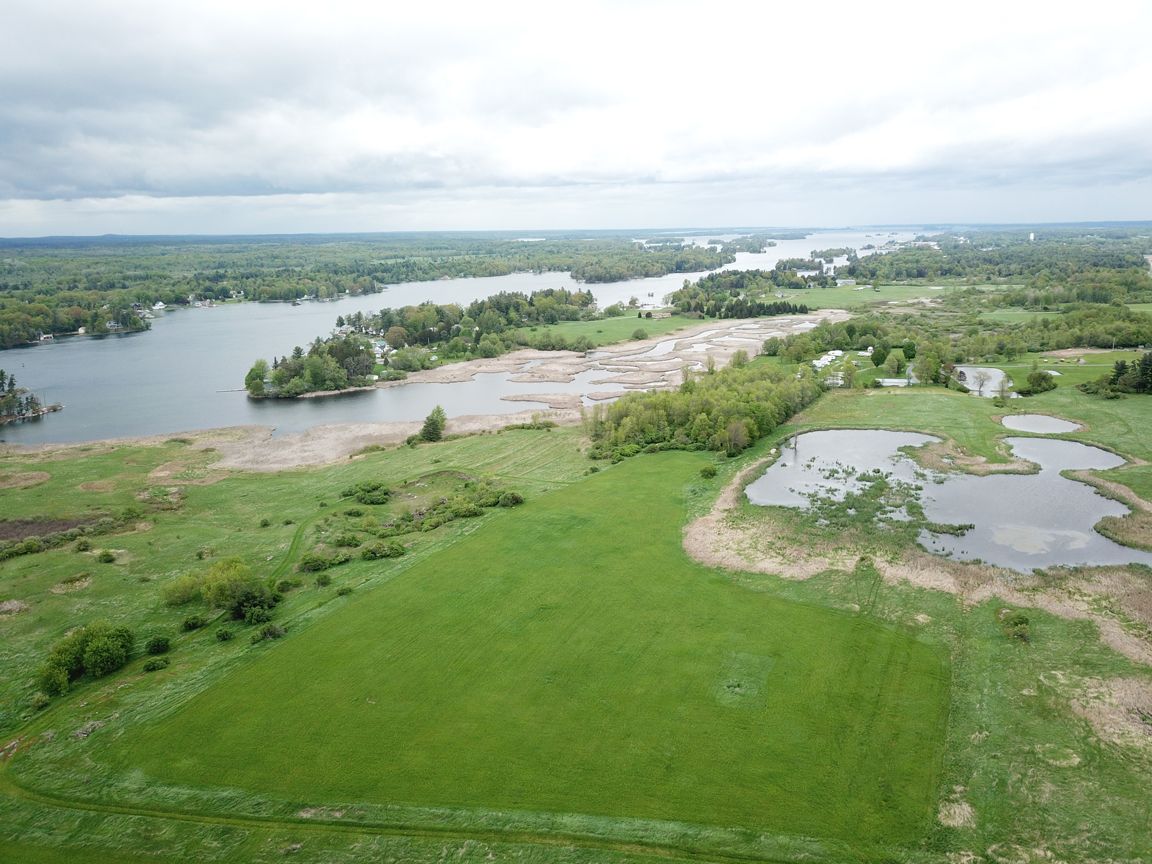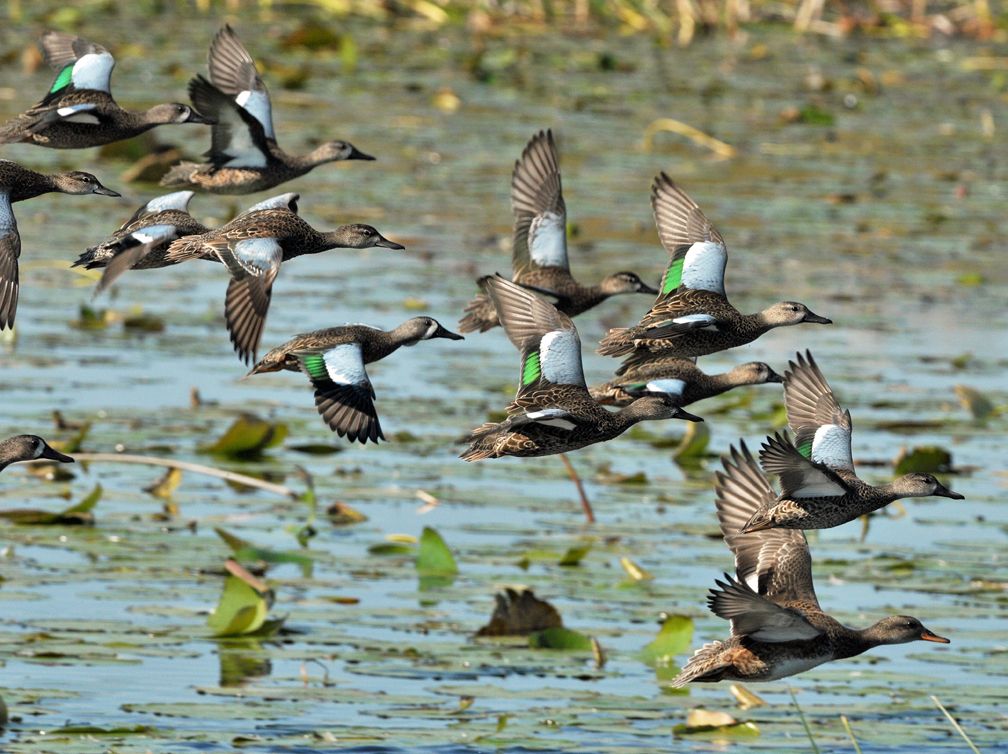Nestled quietly between Point Vivian and St. Lawrence Park, a flock of teal and mallard ducks escape the bustle of the American Narrows. Countless lakers, landing crafts, and pleasure boats pass under the Thousand Islands Bridge just a mile upstream. Garlock Bay is the perfect hideaway, whether you arrive by feather or fin. The restored coastal wetlands and thousands of feet of undeveloped shoreline here provide a rare year-round retreat and stronghold for the region’s wildlife, while also helping to maintain the clean waters that many enjoy along the shores of the St. Lawrence River.
Though not officially labeled as Garlock Bay on navigation charts or USGS topo maps, the scenic embayment behind buoy “205” claims its name from decades of ownership and diligent stewardship by the Garlock family of Alexandria Bay, NY. The late Richard Garlock, a renowned outdoorsman and local businessman, bequeathed this 80+ acre tract to his three daughters, Jennifer Garlock-Hebert, Marcia Slocum, and Deirdre Beers, in 2021. Plans to develop the shoreline have come and gone over the decades, but fortunately the land has been able to avoid that fate.

With their shared vision for the land, and love for the greater Thousand Islands, the Garlock sisters worked with the Thousand Islands Land Trust (TILT) to ensure that Dick’s legacy of stewardship would live on. “Our Dad truly loved the River and this property,” reflected Jennifer Garlock. “It’s hard to describe how much this opportunity means to us. He’d be happy to know that it will stay forever wild, helping protect habitat for the fish and the ducks.”
The Land Trust purchased the property in April 2023, with assistance from the United State Fish & Wildlife Service’s (USFWS) Fish Enhancement, Mitigation and Restoration Fund (FEMRF) and New York State Department of Environmental Conservation. One of the largest stretches of natural riverfront along mainland Jefferson County is now permanently protected.
Notably, last year, Hebert, Slocum, and Beers were contacted by United States Customs & Border Protection, which was interested in conducting bat surveys as part of its efforts to identify a site for the new 48,000 square foot Border Patrol facility. While TILT and the River community recognize the importance of border security, we believe Custom & Border Protection (CBP) is able to advance its mission and at the same time, avoid negatively impacting our region’s most sensitive ecological areas.
"Garlock Bay is a shallow aquatic ecosystem with submerged vegetation that provides critical spawning, rearing, and foraging habitat for many fish species, including the muskellunge – or musky,” explained Ian Drew, Field Supervisor, USFWS. “Musky populations in the St. Lawrence River have experienced a significant and recent decline due to reduced spawning and nursery habitat, as well as losses attributed to a disease known as viral hemorrhagic septicemia (VHS). The maintenance and protection of high-quality spawning and nursery habitat is critical to ensuring population recovery and sustainability.”
In 2012, Ducks Unlimited undertook an extensive wetland restoration project in the upper Garlock Bay complex. The restoration effort was funded by a USFWS Great Lakes Restoration Initiative (GLRI) grant administered through the National Oceanic & Atmospheric Administration (NOAA). “The restoration work aimed to enhance the marsh ecosystem and fish spawning habitat,” explained Sarah Fleming, DU Director of Conservation Programs. “The wetlands were opened up through the use of specialized long-front excavators, and channels and potholes were created in dense stands of cattail. Excavated material was either removed from the site or piled as habitat mounds that support native plants, such as sedges and rushes, providing great sources of food for waterfowl.” Additionally, a second wetland restoration project took place on the property’s interior, as part of a North American Wetland Conservation Act (NAWCA) grant. This program provided for the expansion of an historic emergent wetland that had been partially ditched and drained decades ago. “There has been significant federal investment into the site, and transfer to TILT will ensure long-term protection of the restored natural resources.”
When coupled with permanent protection of the Garlock property, the natural spaces in and around Garlock Bay will serve as long-term spawning and nursery areas for fish that require marsh habitat, such as the northern pike. The potholes will also create isolation areas for waterfowl broods and habitat for other marsh species, such as Blanding’s turtles, Virginia rails, and Least bitterns.
Benefits of Conservation
In addition to the ecological benefits, by conserving areas like Garlock Bay, TILT helps ensure a healthy balance between natural open space and responsible riverfront development. The Trust for Public Land’s economic study, peer reviewed by Clarkson University, concluded that preserves, trails, and conserved open spaces attract visitors to the region, enhance property values, provide recreational opportunities, and boost responsible economic development.
The study assessed the impact of preserves, trails, and conserved open spaces on the region’s economy by drawing from several case studies of TILT Preserves, and illustrated that they are key economic drivers, which collectively contribute millions in economic benefits annually throughout St. Lawrence and Jefferson Counties. In addition, the study clearly identified that preserves, trails, and conserved open spaces, such as Zenda Farms and Otter Creek, have a net positive impact on nearby residential property values, demonstrating that homebuyers seek out and are willing to pay more for a home close to these amenities.
“Residents choosing to call the Thousand Islands home value being close to the region’s preserves, trails, and conserved open spaces. Be it a family home near Zenda Farms Preserve or a summer cottage near one of the several State Parks in the region, these amenities create additional value across our local communities,” explained Martin D. Heintzelman, Associate Professor at Clarkson University.
The premium for proximity to preserves, trails, and open spaces was found to increase market values by 20% or more in the region. Since property tax is related to a home’s value, the increase in property value as a result of a home’s proximity to preserves, trail, and conserved open space leads to additional property taxes generated annually. Generally, this increase in market value and property tax is realized when properties are sold.

This ultimately translates into greater property tax revenues generated annually from homes adjacent to protected spaces, National research over several decades found that this additional tax revenue offsets the costs associated with preserves, trails, and conserved open spaces, as well as any reductions in the total taxable land, refuting the idea that conservation lands result in a net reduction in the value of an area’s tax base.
Just like the proposed plan to move the US border Patrol facility to Blind Bay, If the proposed facility was built in Garlock Bay, there would be an immediate and potentially long-term erosion of the tax base throughout St. Lawrence Park and across Point Vivian and Wellesley Island. The Garlock property is the perfect example of protecting the region’s most critical natural resources, while simultaneously stabilizing the local tax base over the long-term.
For the scenic beauty enjoyed by those in St. Lawrence Park and Point Vivian, or the fishing guides targeting the toothy northern pike, and to all River-enthusiasts yet to come, the protection of the Garlock property is a high-impact conservation achievement well worth celebrating.
Over the coming months, TILT intends to conduct a comprehensive natural resources inventory on the property. This will assist with the development of a long-term management plan, which will guide the property’s use and care into the future.
By Jake Tibbles, Executive Director, Thousand Islands Land Trust
Jake Tibbles was appointed Executive Director in May 2012. He earned a bachelor’s degree in Environmental Science from the State University of New York at Cortland, majoring in both Biology and Chemistry. He first came to the Land Trust in 2007 in a research internship and continued on as Director of Stewardship. Since being appointed Executive Director, he has overseen TILT's Reaccreditation in 2014 and 2019 by the Land Trust Alliance Accreditation Commission, and its growth in conserved lands, in developing educational programs, and staffing.
[Header photo by Spencer Busler, TILT Assistant Director]
For more information about the Thousand Islands Land Trust’s land conservation efforts, visit www.TILandTrust.org.
In addition, the Thousand Islands Land Trust and Save the River are working together to create a Legal Defense Fund with donations and pledges. Together we can ensure that our River is protected for today, tomorrow and many generations to come.
Have your Signed the Save Blind Bay Petition? Please do so now.
Posted in: 'Volume 18, Issue 8, August 2023, Nature, News article, People, Places
Please click here if you are unable to post your comment.
